POLISH TROOPS RELIEVE NEW ZEALANDERS
Monte Cassino, Italy • April 17, 1944
On this date in 1944, 52,000 soldiers of the untested Polish II Corps under Maj. Gen. Wladyslaw Anders quietly moved into position under the cover of darkness and smokescreen. The Polish II Corps, part of Gen. Oliver Leese’s British Eighth Army, relieved the exhausted New Zealand II Corps, which since March had attempted to capture the ruins of the historic Benedictine monastery atop Monte Cassino, part of the Gustav Line, the German main defensive line south of Rome. It was the heavily entrenched German defenses along the Gustav Line and at Cassino that held up the American and British armies moving up the Italian boot, preventing the liberation of the Italian capital some 70–80 miles to the northwest. Assaults on the beautiful 1300‑year-old Benedictine monastery had occurred every month since January, reducing the historic treasure to rubble while giving the enemy sufficient cover from which to rain down artillery on any approaching assault force.
The month before, on March 15, the New Zealanders under Lt. Gen. Bernard Freyberg had tried for a third time to smash through the Gustav Line at Cassino. This time they were assisted by 435 U.S. bombers pummeling the tiny town at the foot of the monastery. Less than half the 2,000 bombs landed on target, and stray bombs caused 142 Allied casualties. Allied gunners battered the town defenders, veterans of the elite German 1st Parachute Division, as well as the abbey with 200,000 more shells, reducing the town to rubble. Between bomb-cratered streets and toppled houses, Allied tanks were stymied in lending support to the New Zealanders, who exhausted themselves picking their way through what remained of the town. After eight days the Germans still held much of the town, and Freyberg called off the attack. The mountain stronghold too was still held by the enemy, 14 determined divisions strong.
On May 12, the Poles abandoned the safety of their foxholes, moved up the tortured hillsides, and received a baptism of fire. On the 17th, they succeeded in outflanking the enemy, which had begun to withdraw due to Allied breakthroughs elsewhere along the Gustav Line, allowing the Poles to capture outposts the enemy had held for the past five months. The next day, May 18, in a race between Polish and British soldiers to the summit, a Polish regiment first raised its regimental pennant above the ruins of the monastery, followed a short time later by the British raising their flag. For their bravery, men of the Polish II Corps were honored to permanently wear the Eighth Army shield on their right shoulder even if, in the future, they were no longer part of the Eighth.
Battle of Monte Cassino, January 17 to May 18, 1944
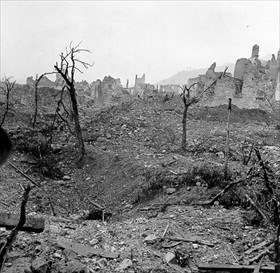 | 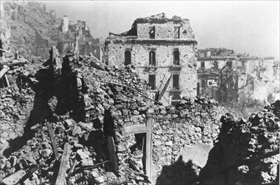 |
Left: Ruins of the town of Cassino after the hellish four-month battle and stalemate. In the background are the ruins of the Abbey of Monte Cassino. The abbey lay just over one mile to the west of the town at an elevation of 1700 ft and had a commanding view of the Liri and Rapido valleys, southern gateways to Rome, the first of the Axis European capitals that would fall to the Allies (June 4, 1944). The four battles to take Cassino and its abbey cost the lives of more than 14,000 men from a dozen Allied nations, while inflicting 350,000 casualties on all sides. The Monte Cassino stalemate severely set back the Allied timetable for ridding Italy of Germans.
![]()
Right: Interior of the ruined abbey. On February 15, 1944, in a controversy that still resonates, 83 U.S. 11th Air Force bombers unloaded 1,400 tons of bombs on the abbey, leaving behind masses of shattered stone and smoking ruins. The Allies claimed the Germans were using the abbey as an artillery observation post and had artillery positions inside it, a claim that monks at the abbey strenuously denied. The Germans had, however, manned some positions set into the steep slopes 50 yards below the abbey’s walls.
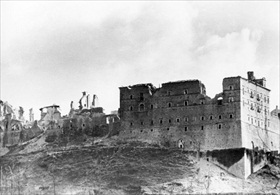 | 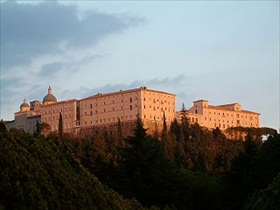 |
Left: Monte Cassino in ruins, February 1944. St. Benedict of Nursia established his first monastery, the source of the Benedictine Order, here around AD 529 and over time it become a repository of valuable art works and a world-renowned library.
![]()
Right: The restored Abbey of Monte Cassino sits on rocky hill about 80 miles southeast of Rome. It is still one of the most famous monasteries in Christendom.
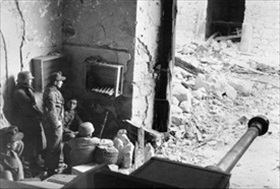 | 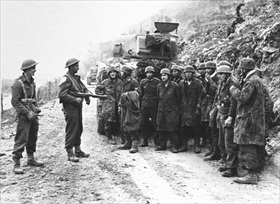 |
Left: Men of the German 1st Parachute Division take up positions inside the crumbled walls of the abbey. The men used the rubble to their advantage to rain down artillery, mortar, and machine gun fire on those wanting to claw their way up the flinty slopes to the summit.
![]()
Right: New Zealanders with captured German paratroopers. Only about 100 Germans surrendered to the Allies. Others sought to break out as the Allies closed in on the makeshift German fortress. Joseph Goebbels’ Propaganda Ministry glorified the dedication of the fortress defenders without mentioning that the abbey had fallen to the Allies.
The Controversial Battle of Monte Cassino: Contemporary Footage, Interviews, and Reenactments
![]()

 History buffs, there is good news! The Daily Chronicles of World War II is now available as an ebook for $4.99 on Amazon.com. Containing a year’s worth of dated entries from this website, the ebook brings the story of this tumultuous era to life in a compelling, authoritative, and succinct manner. Featuring inventive navigation aids, the ebook enables readers to instantly move forward or backward by month and date to different dated entries. Simple and elegant! Click
History buffs, there is good news! The Daily Chronicles of World War II is now available as an ebook for $4.99 on Amazon.com. Containing a year’s worth of dated entries from this website, the ebook brings the story of this tumultuous era to life in a compelling, authoritative, and succinct manner. Featuring inventive navigation aids, the ebook enables readers to instantly move forward or backward by month and date to different dated entries. Simple and elegant! Click 











